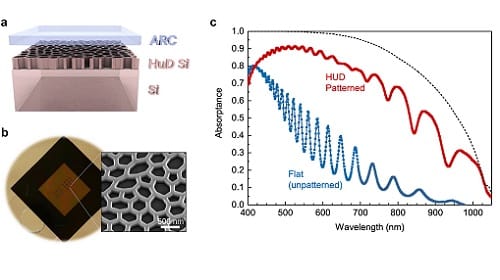Researchers took inspiration from “birds-eye” and designed a disordered honeycomb layer to register the highest ever efficiency in a 1-micrometer thick solar panel.

A team led by researchers from the University of Surrey was able to achieve an efficiency of 21% which is 25% higher than the most efficient thin-film solar panel ever tested. The 1-micrometer thick solar panel (1μm) was able to achieve absorption rates of 26.3ma/cm2. The team drew inspiration from the shape of bird eyes and butterfly wings to draw a honeycomb-like design, enabling higher light absorption. The research is published in the American Chemical Society’s Photonics journal. The finding could help improve the efficiency of thin-film solar panel and also benefit other industries such as photo-electrochemistry, solid-state light emission, etc. where surface engineering and light management is crucial.
The main challenge with the photovoltaic system is to increase the absorption of solar irradiance. About one-third of light falling on the PV cell is reflected back, to improve the absorption rate, the team took inspiration from nature and designed a disordered honeycomb layer on top of a silicon wafer. The design enhances the absorption of light falling from any angle and traps it inside the PV cell, thus enabling higher energy generation.
“One of the challenges of working with silicon is that nearly a third of light bounces straight off it without being absorbed and the energy harnessed. A textured layer across the silicon helps tackle this and our disordered, yet hyperuniform, honeycomb design is particularly successful.” Said Dr. Marian Florescu, University of Surrey’s Advanced Technology Institute (ATI). “There’s enormous potential for using ultra-thin photovoltaics. For example, given how light they are, they will be particularly useful in space and could make new extra-terrestrial projects viable. Since they use so much less silicon, we are hoping there will be cost savings here on Earth as well, plus there could be potential to bring more benefits from the Internet of Things and to create zero-energy buildings powered locally.”
The tests were performed in a laboratory under controlled conditions, where the PV cell achieved an efficiency of 21%. The team is certain that they will be able to push the figure higher, therefore, achieving much higher efficiency than most commercially available photovoltaics.






